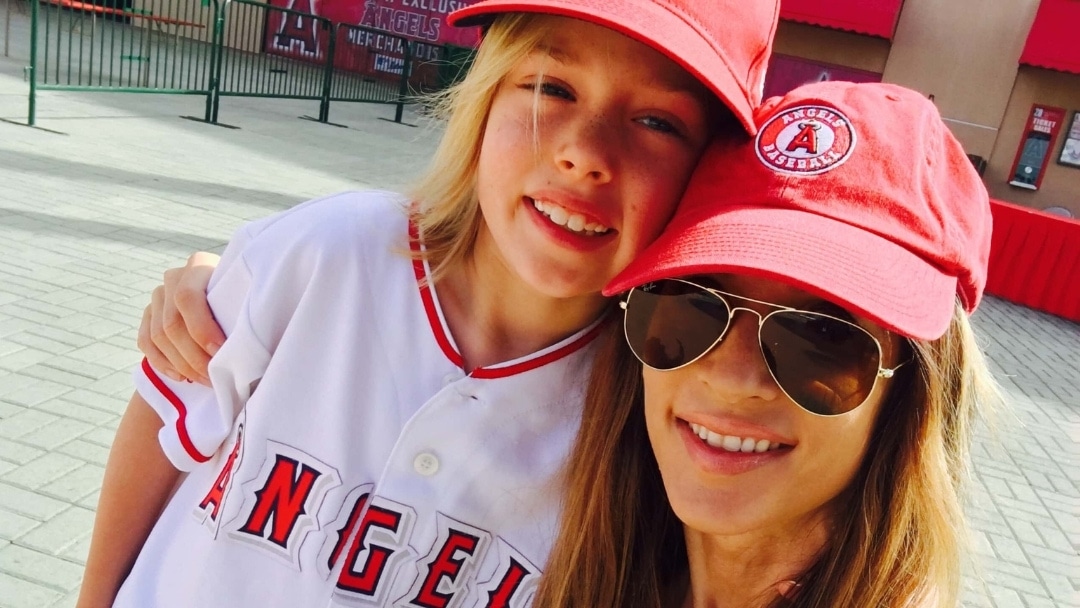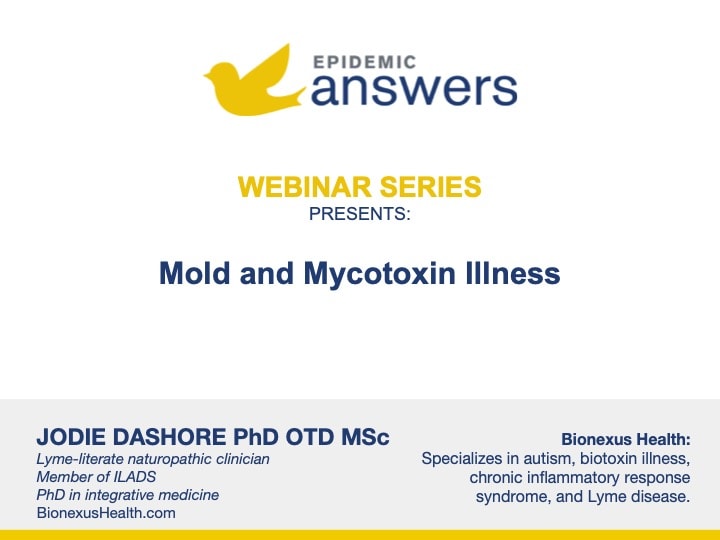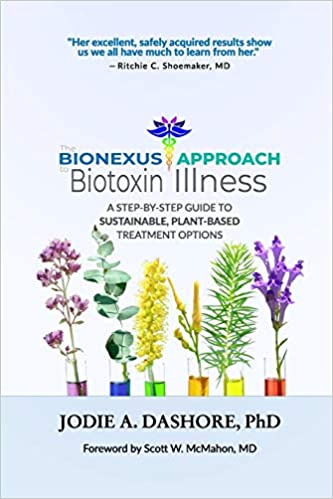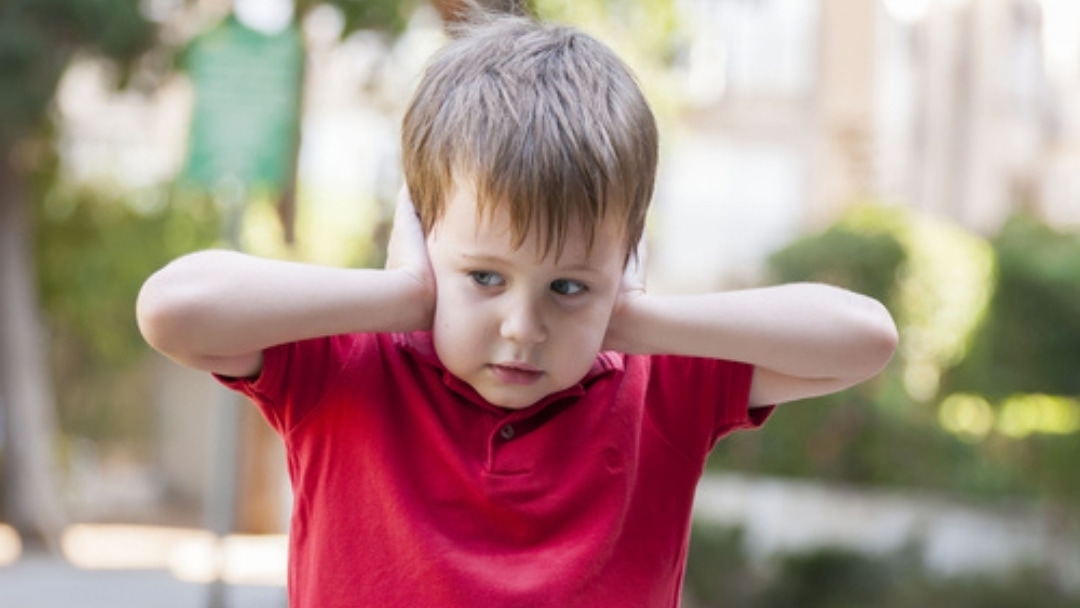We interviewed Christian Bogner MD CFMNP FACOG about mold and autism. You can listen to the replay below. Please note that you will be asked to provide your email address at the 30-minute mark to continue viewing the replay.
Mold and Autism
There are a few documented cases of the complete reversal of autism symptoms with the treatment of the mycotoxins produced by mold. In one case, such as this peer-reviewed article by Drs. Sidney Baker and William Shaw, it was achieved with antifungal drugs. In another case, it was achieved with the removal of a child from a home with unseen mold in addition to biomedical interventions for the child.
In such cases, the child is typically tested with a special urine test such as Great Plains Laboratory’s MycoTox Profile that looks for biochemical markers consistent with fungal (Aspergillus) colonization of the gastrointestinal tract. Additional tests could include testing for certain SNPs (single nucleotide polymorphisms) in the child’s DNA as well as testing for neurotransmitter imbalances.
Another way to test the hypothesis that mold in the home and child are causing symptoms of autism is to remove the child from the home for a period of time, such as when going on vacation for a few days or a week. If symptoms improve, this is a strong indicator that something in the child’s home environment could be contributing to the total load of symptoms.
Yet another way to test the mold hypothesis is to give the child the antifungal probiotic Saccharomyces boulardii (under a practitioner’s guidance, of course). A dramatic Herxheimer reaction provides a strong indications that mold colonization might be a factor.
In our experience, if you’ve tried everything in getting to the root of your child’s autism symptoms, you’ll want to investigate mold as a factor. It could be *the* one major thing that needs to be addressed.
In This Webinar
Dr. Christian Bogner uses a functional-medicine approach to treat children with autism. He uses a variety of testing methodologies to confirm his hypothesis that mold may be playing a factor in autism symptoms. In this webinar, he helped us to understand:
- When should mold be suspected as a cause of autism symptoms?
- How common is mold illness/exposure in a child with autism? (Answer: Very. Of the hundreds of Dr. Bogner’s autism cases, only one child did not have mold as a factor.)
- What kind of symptoms does a person with mold and mycotoxin illness exhibit?
- Which tests can be used for the child to determine if mold is a factor?
- Which diet(s) can help with mold and mycotoxin illness?
- Are there common foods that are a concern for mold and mycotoxin illness?
- How can a home be tested for mold?
- Do most homes have mold?
- Is it worth spending tens of thousands of dollars or more to remediate a mold-infested home?
- What kinds of treatments help with mold and mycotoxin illness?
- What are examples of success stories of children with autism who have been treated for mold?
- What is the role of EMFs (electromagnetic frequencies) on mold and autism?
- How glyphosate, heavy metals and other toxins contribute to the total load on a body and impede the immune system from doing its job of getting rid of mycotoxins and biotoxins.
- Why PANS/PANDAS, Lyme disease, HHV-6 and other infections tend to also be present in a child with mold illness and/or autism.
- Why Mast Cell Activation Syndrome is common in a child with mold illness and/or autism.
Key Discussions
The key discussions in this webinar reflect an integrative approach to understanding and managing the impact of mold on individuals, particularly those with autism, and the importance of individualized care that takes into account environmental, dietary, genetic, and emotional factors.
Mold Contamination and Food Sources
Understanding the prevalence of mold contamination in crop fields and processed foods. Identification of foods that exacerbate or help combat mold toxins.
Diets and Genetic Susceptibility
The importance of genetic testing in tailoring diets, such as ketogenic or paleo, to fit individual health needs and susceptibilities.
Home Mold Testing and Remediation
Guidelines for when to test homes for mold and various remediation strategies to address mold issues.
Antifungal Treatments
The use of antifungal medications like amphotericin B and etraconazole to target mold in the body, as well as alternative treatments like ozone and hyperbaric oxygen therapy.
Mold’s Impact on Health
Discussing the extensive impact of mycotoxins on human health, potentially leading to complex diseases and conditions.
Environmental and Internal Factors
The role of both environmental exposure and internal factors, including genetics and diet, in mold-related health issues.
Functional Approach to Treatment
The recording emphasizes the importance of a holistic functional approach to treatment that looks beyond autism as a general diagnosis and focuses on addressing specific symptoms and underlying issues.
Understanding and Treating Autism
Advocating for a comprehensive view of autism that includes looking into environmental factors, diet, lifestyle, and genetic predispositions.
Mold and Autism Connection
Exploring the connection between mold exposure and autism symptoms, with an emphasis on testing for mold toxins as a potential root cause.
Underestimated Intelligence in Autism
Highlighting the intelligence and abilities of people with autism and discussing methods such as “spelling to communicate” that reveal the cognitive abilities of non-verbal individuals.
Comprehensive Care and Collaboration
The need for intensive, individualized patient care and the benefits of collaborative efforts among healthcare practitioners specializing in autism and related health issues.
The Influence of Mindset and Emotions
The importance of considering the emotional, mental, and spiritual aspects of health, especially when addressing autism and other complex conditions.
Ongoing Research and Education
The importance of continued research, education, and open-mindedness in the field of autism and the pursuit of more effective treatment strategies.
Timestamped Overview
00:00 Epidemic Answers: promoting children’s health and well-being.
06:30 Integrating medical systems for comprehensive patient care.
16:00 Glyphosate causes harm, found in many products.
18:59 Mold suppresses immune system, causing health issues.
25:02 Mold thrives in moist, carbon-rich environments.
31:02 Gene testing for autism and health influence.
33:43 Interrelationship between genes fascinating.
40:01 Addressing autism-related challenges, emphasizing the need for help.
44:08 Interviewed experts on fecal transplants, gut microbiome.
58:31 Survey finds mold in one-fourth of crops.
01:02:55 Genetics test crucial for personalized dietary recommendations.
01:07:01 Check damp areas for mold, limit plants.
01:13:44 The link between mold, immune system.
01:21:24 Research on mold detox with serotonin withdrawal.
01:24:00 Mold toxins in blood.
01:29:03 Some healthy snacks have mold; try Bulletproof coffee.
01:33:11 Effective medications for yeast and mold treatment.
01:42:03 Mutual learning from diverse individuals is valuable.
01:43:11 Decrease exposure to histamine and adrenaline.
About Christian Bogner MD CFMNP FACOG
Dr. Christian Bogner is a lecturer, educator and experienced practicing clinician. His services specialize in online education for his patients.
He is a functional medicine certified physician with additional board certification in OBGYN. He has obtained his certification in Plant-Based-Nutrition from Cornell University.
He provides functional medicine education and counseling as the CEO of Bogner Health, LLC in Michigan, which offers laboratory test interpretation education for individuals with complex medical conditions such as autoimmune diseases and mental health disorders.

Dr. Bogner is a clinical consultant for MaxGen Labs, LLC, a nutrigenomics lab analyzing genetic data, utilized by over 800 practitioners around the world. He has lectured throughout the United States and abroad regarding integrative approaches to disease with a focus on genetics, neurotransmitters and toxicities. You can find out more about him and his practice at his website https://www.drbognerhealth.com/
Disclaimer
This webinar is not a substitute for medical advice, treatment, diagnosis, or consultation with a medical professional. It is intended for general informational purposes only and should not be relied on to make determinations related to treatment of a medical condition. Epidemic Answers has not verified and does not guaranty the accuracy of the information provided in this webinar.
Still Looking for Answers?
Visit the Epidemic Answers Practitioner Directory to find a practitioner near you.
Join us inside our online membership community for parents, Healing Together, where you’ll find even more healing resources, expert guidance, and a community to support you every step of your child’s healing journey.
Sources & References
Baker, S., et al. Case Study: Rapid Complete Recovery From An Autism Spectrum Disorder After Treatment of Aspergillus With The Antifungal Drugs Itraconazole And Sporanox. Integr Med (Encenitas). 2020 Aug;19(4):20-27.
Bennett, J.W., et al. Mycotoxins. Clinical Microbiology Reviews. Jul 2003: 497-516.
Berndtson, K., et al. Medically sound investigation and remediation of water-damaged buildings in cases of CIRS-WDB. Center for Research on Biotoxin Associated Illness. 2016 Jan 19.
Berry, Y. A Physician’s Guide to Understanding and Treating Biotoxin Illness. 2014.
de Allori, M.C.G., et al. Antimicrobial resistance and production of biofilms in clinical isolates of coagulase-negative Staphylococcus strains. Biol Pharm Bull. 2006 Aug;29(8):1592-6.
De Santis, B., et al. Role of mycotoxins in the pathobiology of autism: A first evidence. Nutr Neurosci. 2019 Feb;22(2):132-144.
De Santis, B., et al. Study on the Association among Mycotoxins and other Variables in Children with Autism. Toxins (Basel). 2017 Jun 29;9(7):203.
Hope, J. A review of the mechanism of injury and treatment approaches for illness resulting from exposure to water-damaged buildings, mold, and mycotoxins. ScientificWorldJournal. 2013 Apr 18;2013:767482.
Hudnell, H.K. Chronic biotoxin-associated illness: multiple-system symptoms, a vision deficit, and effective treatment. Neurotoxicol Teratol. Sep-Oct 2005;27(5):733-43.
Institute of Medicine (US) Committee on Damp Indoor Spaces and Health. Damp Indoor Spaces and Health. Washington (DC): National Academies Press (US); 2004.
Kali, A. Antibiotics and bioactive natural products in treatment of methicillin resistant Staphylococcus aureus: A brief review. Pharmacogn Rev. Jan-Jun 2015;9(17):29-34.
Kontoyiannis, D.P., et al. Treatment principles for the management of mold infections. Cold Spring Harb Perspect Med. 2014 Nov 6;5(4):a019737.
Oliva, A., et al. High Potency of Melaleuca alternifolia Essential Oil against Multi-Drug Resistant Gram-Negative Bacteria and Methicillin-Resistant Staphylococcus aureus. Molecules. 2018 Oct 9;23(10):2584.
Ratnaseelen, A.M., et al. Effects of Mycotoxins on Neuropsychiatric Symptoms and Immune Processes. Clin Ther. 2018 Jun;40(6):903-917.
Salari, M.H., et al. Antibacterial effects of Eucalyptus globulus leaf extract on pathogenic bacteria isolated from specimens of patients with respiratory tract disorders. Clin Microbiol Infect. 2006 Feb;12(2):194-6.
Shoemaker, R.C., et al. Sick building syndrome (SBS) and exposure to water-damaged buildings: time series study, clinical trial and mechanisms. Neurotoxicol Teratol. Sep-Oct 2006;28(5):573-88.
Shoemaker, R.C., et al. Structural brain abnormalities in patients with inflammatory illness acquired following exposure to water-damaged buildings: a volumetric MRI study using NeuroQuant®. Neurotoxicol Teratol. Sep-Oct 2014;45:18-26.
Shoemaker, R.C., et al. A time-series study of sick building syndrome: chronic, biotoxin-associated illness from exposure to water-damaged buildings. Neurotoxicol Teratol. Jan-Feb 2005;27(1):29-46.
Resources
Articles
Dr. Shoemaker’s 11 Step Treatment Protocol
Books
Dashore, Jodie. The BioNexus Approach to Biotoxin Illness. Blurb, 2020.
Shoemaker, Ritchie MD, et al. The Art and Science of CIRS Medicine. BookBaby, 2020.
Shoemaker, Ritchie MD, et al. Surviving Mold: Life in the Era of Dangerous Buildings. Otter Bay Books, 2010.
Vetter, Paula. Mold Illness: Surviving and Thriving: A Recovery Manual for Patients & Families Impacted By CIRS. BookBaby, 2018.
Websites
Videos
The Great Plains Laboratory: Autism and Mold Exposure: Why Testing for Mycotoxins is So Important



